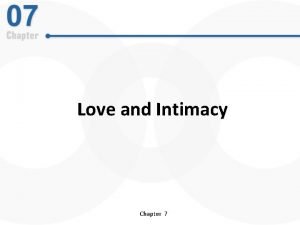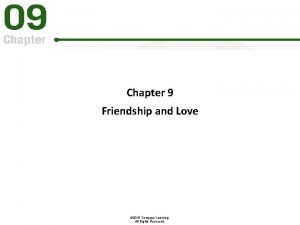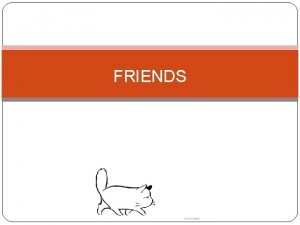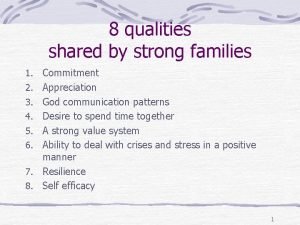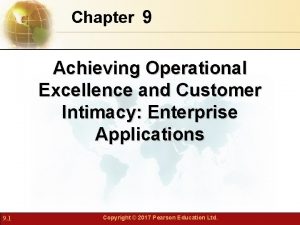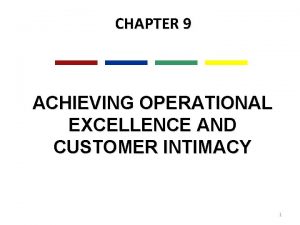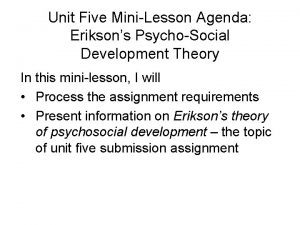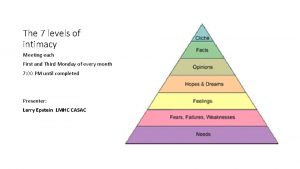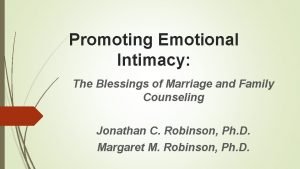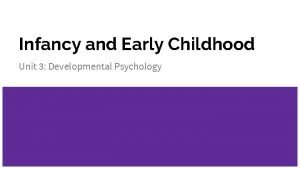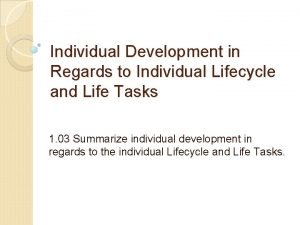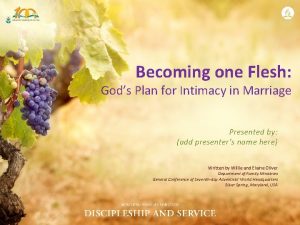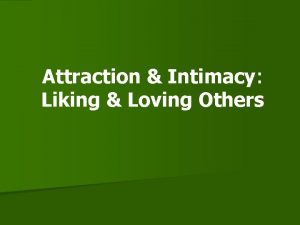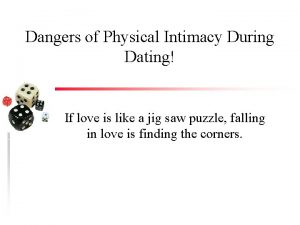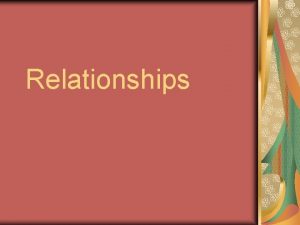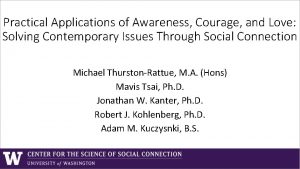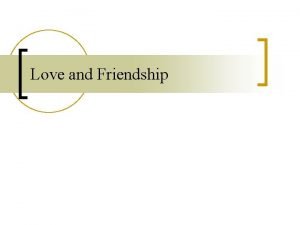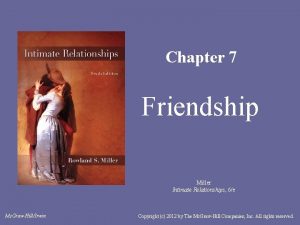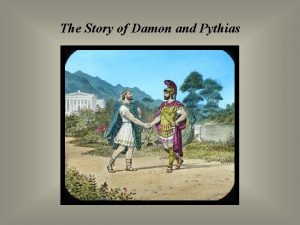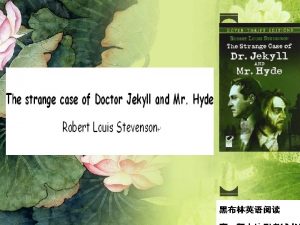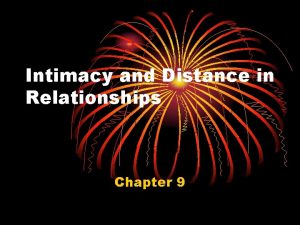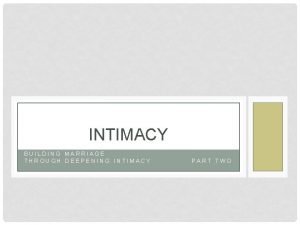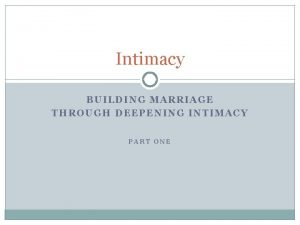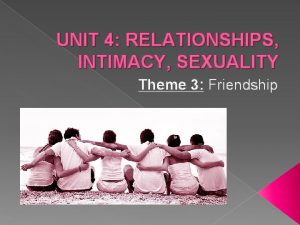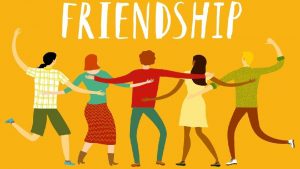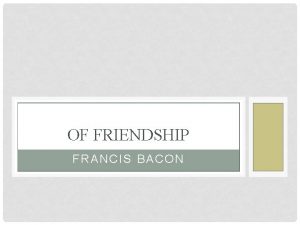Chapter 5 Friendship Love and Intimacy Love Opinionaire









































- Slides: 41

Chapter 5 Friendship, Love, and Intimacy

Love Opinionaire § § § § § Love gives meaning to our lives. Love is essential to our lives. Love encompasses opposites. (bonds and freedom, stability and change). It is easier to love someone than to like someone. Love is blind. There is no such thing as falling in love. Love is both a feeling and an activity. Love strikes powerfully upon first sight. Love conquers all.

WHICH STATEMENTS ARE MYTHS OF LOVE & MARRIAGE? § § § § If you love, you should marry. There is one and only one for you. You can only love one person at a time. You will marry your first real love. Opposites attract is a good motto to follow. Love is natural and easy. Once in love you have it made (love sustains itself). Young people can't love.

So what is this crazy little thing called love?

We want to be in love. We want to feel “magic. ” § We want someone with whom we can spend the rest of our lives. § We want to be and feel “completed. ” § We want to make “the ride” worthwhile. §

The Need for Intimacy Humans require other humans with whom we feel close and to whom we can commit. § We need to form relationships in which we can share ourselves with others, exchange affection, and feel connected. §

Intimacy Refers to closeness between two people. § Consists of four key features § – Presence of love and/or affection – Personal validation – Trust – Self-disclosure

Intimacy Benefits Buffers us against loneliness § Provides us with positive feelings about ourselves and others § Gives us confidence that our needs will be fulfilled in the future § Enhances our self-esteem §

Intimacy Benefits Intimate relationships are connected to happiness, contentment, and a sense of wellbeing. § Protects us from some stressrelated symptoms § Reduces our likelihood of illness, depression, and accidents §

Intimacy Expressed § § § Talking together Listening to each other Making time for each other Being open and honest with each other Trusting each other

Importance of Intimacy More important than independence § More important than agreement § More important than sexuality § § Research shows that intimacy is important in other countries.

Love and Friendship § § § Hard to define The most important sources of intimacy we have. Bind us together Provide emotional sustenance Help preserve our physical and mental well-being

Romantic Love Part of a contemporary U. S. marriage § Consequences of romantic love in marriage § – Tendency to idealize partner – Tendency to display affection toward the partner – Tendency to attach more importance to sexual intimacy

Homogamy The tendency to marry people much like themselves. § Tends to bring more rationality to the picking of our mates. §

Romanticism § In individualistic cultures, such as the U. S. , people value passionate love, “an intense longing for another. ”

Romanticism In collectivist cultures, including many Asian societies such as Japan, China, India, and Korea, individual happiness is subordinated to group well-being. § High value is placed on companionate love, a less intense emotion in which warm affection and tenderness is felt and expressed. §

Romanticism elements Love conquers all. § For each person there is “one and only one” romantic match. § Our beloved should and will meet our highest ideals. §

Romanticism elements Love can and often most powerfully does strike “at first sight. ” § We should follow the heart not the mind when choosing a partner. §

Gender and Intimacy § Men – Maintain greater emotional distance – Men display love by doing things – Sex and physical closeness displays love. – Try to solve problems rather than just listen

Gender and Intimacy § Women – Relate more easily and deeply with others – Develop a great capacity for disclosing and sharing their inner selves – Want to share love and affection – Expressing warm feelings toward someone – Negotiate for closeness by trying to reach agreement – Give and receive support – Women express more empathy

Gender and Love Men are likely to use, “I love you, ” to increase the likelihood that their partner will agree to have sex with them. § Men don’t always have available male role models and thus inhibit their own emotional expressiveness, identifying such behavior as type of mothers and women and to be avoided. §

Gender and love Men fall in love more quickly than women. § Men are more likely than women to separate sex from affections. Women generally view sex from a relational perspective. § Women generally seek emotional relationships. § Men may initially seek physical relationship. §

Prototypes of Love Your thoughts: The book says that despite centuries of discussion no one has succeeded in finding a definition of love on which all can agree. § Prototypes: definitions of love stored in the backs of our minds. A somewhat invisible list of what we want. §

Loving Behaviors § § § § Verbal Expressions Self-disclosing (revealing intimate facts about oneself) Offering emotional and moral support Expressing nonverbal feelings such as happiness, contentment and security when the other is present Giving gifts or doing favors Giving hugs, kisses and making love Tolerating and accepting the other’s idiosyncrasies or annoying habits.

Lee’s Six Basic Styles of Love (Hendrick’s Love Attitude Scale) 1. 2. 3. 4. 5. 6. Eros: love of beauty Ludus: playful love Storge: companionate love Mania: obsessive love Agape: altruistic love Pragma: practical love

Lee’s Six Basic Styles of Eros Love Agape Manic Balanced Love Storge Ludic Pragma

Sternberg’s Triangular Theory of Love The passion, intimacy, and decision/components of love can be combined in a variety of ways to form differently shaped triangles. These shapes may change over time.

Triangular theory of love § Views love as consisting of three components: – Intimacy – Passion – Decision/commitment

Triangles of Love

Commitment, Passion, and Intimacy Type Commitment Passion Intimacy Liking - - + Infatuation – + – Empty love + – – Romantic love – + +

Commitment, Passion, and Intimacy Type Commitment Passion Intimacy Companionate love + – + Fatuous love + + – Consummate love + + +

Attachment Theory of Love Views love as being similar in nature to attachments we form as infants. § All important relationships especially the first with parents and later with lovers and spouses are attachments. § The attachment (love) styles of both infants and adults are: § – Secure – Anxious/ambivalent – Avoidant

Infant attachment vs. Romantic love Object of attachment is responsive & sensitive § Infant happy around them § Talks to them § Feelings of oneness. § Object of attachment is interested and reciprocates § Person feels happier around lover § Lovers coo, talk baby talk and sing § There are feelings of oneness with lover §

1. Secure adult: Easy to get close to. No fear of abandonment. Felt others liked them. Felt others were good hearted. § Most likely to have a lasting romantic love that is happy, trusting and supportive. §

2. Anxious/Ambivalent Adults: Wanted others to get closer. § Fear that lovers would leave them. § Wanted to merge completely with the other person. § Easy to fall in love but obsessive, jealous, emotional highs & lows. §

3. Avoidant Adults: Discomfort in closeness, distrustful & fear of dependence. § Partners wanted more closeness but they fear intimacy. Have jealousy and emotional highs and lows. § Most likely to break up. § Short relationship. §

Jealousy Occurs because of a partner’s real, imagined, or likely involvement with a third person. § Most likely in committed relationships because of the presumed “specialness” of the relationship. § Fear of loss, coupled with insecurity, increases the likelihood of jealousy. §

Types of Jealousy § Suspicious jealousy § Reactive jealousy

Time and Romance Time affects romantic relationships. § The rapid growth of intimacy tends to level off, and we become habituated to passion. § Commitment tends to increase, provided that the relationship is judged to be rewarding. §

Disappearance of Passion Often experienced as a crisis in a relationship § College student study showed 50% would seek divorce if passion disappeared from marriage. §

Reemergence of Romantic love Most studies suggest marital satisfaction proceeds along a U-shaped curve, with highest satisfaction in early and late periods. § Making love stay: § – Commitment – Caring (placing other needs beyond our own) Buber’s I-it versus I-thou. – Self-Disclosure
 Types of love in your life
Types of love in your life Characteristics of infatuation
Characteristics of infatuation Love love jesus is love god greatest gift lyrics
Love love jesus is love god greatest gift lyrics Love friendship learning
Love friendship learning From friendship comes love
From friendship comes love Customer relationship management and customer intimacy
Customer relationship management and customer intimacy Intimacy and passion without commitment
Intimacy and passion without commitment Achieving operational excellence and customer intimacy
Achieving operational excellence and customer intimacy Achieving operational excellence and customer intimacy
Achieving operational excellence and customer intimacy Customer relationship management and customer intimacy
Customer relationship management and customer intimacy Intimacy
Intimacy Maladaptation of industry vs inferiority
Maladaptation of industry vs inferiority Levels of intamacy
Levels of intamacy What is emotional intimacy
What is emotional intimacy How to solve a love triangle
How to solve a love triangle Anal personality
Anal personality Intimacy vs isolation
Intimacy vs isolation Erik erikson industry vs inferiority
Erik erikson industry vs inferiority Contoh inisiatif perusahaan untuk get keep grow
Contoh inisiatif perusahaan untuk get keep grow Dua for intimacy
Dua for intimacy Trust vs mistrust example
Trust vs mistrust example Waardestrategieën van treacy en wiersema
Waardestrategieën van treacy en wiersema The impact of incarceration on intimate relationships
The impact of incarceration on intimate relationships Sample strategy map
Sample strategy map Becoming one intimacy in marriage
Becoming one intimacy in marriage Intimacy motivation
Intimacy motivation Strategy map example
Strategy map example Intimacy ladder
Intimacy ladder Intimacy funnel
Intimacy funnel Emotional intimacy
Emotional intimacy Fap intimacy scale
Fap intimacy scale Difference between friendship and relationship
Difference between friendship and relationship Friendly relationship ch 9
Friendly relationship ch 9 Friendly relationship chapter 7
Friendly relationship chapter 7 Friendship relationship chapter 7
Friendship relationship chapter 7 The salvation of man is through love and in love
The salvation of man is through love and in love That you must love me and love my dog summary
That you must love me and love my dog summary Pythias and damon story
Pythias and damon story The symbol of welcome, friendship and hospitality is a(n)
The symbol of welcome, friendship and hospitality is a(n) Eclesiastes 4 9 12
Eclesiastes 4 9 12 Why has lanyon and jekyll’s friendship cooled
Why has lanyon and jekyll’s friendship cooled Bridge to terabithia 3
Bridge to terabithia 3
